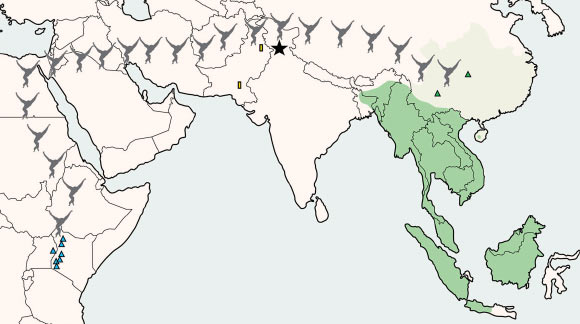Apes: India
This is a collection of articles archived for the excellence of their content. |
Kapi Ramnagarensis
Summary
By Ruchika Uniyal, The Times of India
Tooth helps find ape species that roamed India 13m years ago
An international team of researchers has discovered a new ape species — ancestor of the modern-day gibbon — which lived in north India 13 million years ago after they stumbled upon a fossilised tooth sticking in dirt in the hills of Jammu & Kashmir. After a series of tests and analysis determined that the fossil — a complete lower molar measuring about 7mm in length — belonged to a previously unknown genus and species, researchers named it Kapi ramnagarensis. The findings were published in the Proceedings of the Royal Society B
Details from Sci News.com
Named Kapi ramnagarensis, the new primate species lived approximately 12.5-13.8 million years ago (Middle Miocene epoch) and was distinct from all other known fossil apes.
Its complete lower molar was collected in 2015 from the Lower Siwaliks of Ramnagar in Jammu and Kashmir, India.
It represents the first new hominoid species discovered at the Ramnagar site in nearly a century and the first new Siwalik ape species in more than three decades.
“We knew immediately it was a primate tooth, but it did not look like the tooth of any of the primates previously found in the area,” said lead author Dr. Christopher Gilbert, a researcher in the Department of Anthropology at Hunter College of the City University of New York and the Division of Paleontology at the American Museum of Natural History.
“From the shape and size of the molar, our initial guess was that it might be from a gibbon ancestor, but that seemed too good to be true, given that the fossil record of lesser apes is virtually nonexistent.”
“There are other primate species known during that time, and no gibbon fossils have previously been found anywhere near Ramnagar.”
“So we knew we would have to do our homework to figure out exactly what this little fossil was.”
Dr. Gilbert and colleagues photographed and CT-scanned the specimen and compared it with teeth of living and extinct apes.
“What we found was quite compelling and undeniably pointed to the close affinities of the 13-million-year-old tooth with gibbons,” said co-author Dr. Alejandra Ortiz, a scientist in the Department of Anthropology at New York University and the Institute of Human Origins at Arizona State University.
“Even if, for now, we only have one tooth, and thus, we need to be cautious, this is a unique discovery.”
“It pushes back the oldest known fossil record of gibbons by at least 5 million years, providing a much-needed glimpse into the early stages of their evolutionary history.”
The age of the fossil is contemporaneous with well-known great ape fossils, providing evidence that the migration of great apes, including orangutan ancestors, and lesser apes (gibbons and siamangs) from Africa to Asia happened around the same time and through the same places.
“We found the biogeographic component to be really interesting,” said co-author Dr. Chris Campisano, a researcher in the Institute of Human Origins and the School of Human Evolution and Social Change at Arizona State University.
“Today, gibbons and orangutans can both be found in Sumatra and Borneo in Southeast Asia, and the oldest fossil apes are from Africa.”
“Knowing that gibbon and orangutan ancestors existed in the same spot together in northern India 13 million years ago, and may have a similar migration history across Asia, is pretty cool.”
The discovery of Kapi ramnagarensis is reported in a paper in the Proceedings of the Royal Society B.
